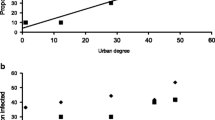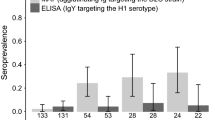Abstract
The reduced species richness typical of oceanic islands provides an interesting environmental setup to examine in natura the epidemiological dynamics of infectious agents with potential implications for public health and/or conservation. On Amsterdam Island (Indian Ocean), recurrent die-offs of Indian yellow-nosed albatross (Thalassarche carteri) nestlings have been attributed to avian cholera, caused by the bacterium Pasteurella multocida. In order to help implementing efficient measures for the control of this disease, it is critical to better understand the local epidemiology of P. multocida and to examine its inter- and intra-annual infection dynamics. We evaluated the infection status of 264 yellow-nosed albatrosses over four successive breeding seasons using a real-time PCR targeting P. multocida DNA from cloacal swabs. Infection prevalence patterns revealed an intense circulation of P. multocida throughout the survey, with a steady but variable increase in infection prevalence within each breeding season. These epizootics were associated with massive nestling dies-offs, inducing very low fledging successes (≤ 20%). These results suggest important variations in the transmission dynamics of this pathogen. These findings and the developed PCR protocol have direct applications to guide future research and refine conservation plans aiming at controlling the disease.



Similar content being viewed by others
References
Andersen PK, Gill RD (1982) Cox’s regression model for counting processes: a large sample study. The Annals of Statistics 10:1100–1120
Bates D, Mächler M, Bolker B, Walker S (2015) Fitting linear mixed-effects models using lme4. Journal of Statistical Software 67: 5. DOI: 10.18637/jss.v067.i01
Blanchong JA, Samuel MD, Mack G (2006a) Multi-species patterns of avian cholera mortality in Nebraska’s Rainwater Basin. J Wildl Dis 42:81–91. https://doi.org/10.7589/0090-3558-42.1.81
Blanchong JA, Samuel MD, Mack G (2006b) Multi-species patterns of avian cholera mortality in Nebraska’s Rainwater Basin. Journal of Wildlife Diseases 42:81–91
Boulinier T, Kada S, Ponchon A, Dupraz M, Dietrich M, Gamble A, Bourret V, Duriez O, Bazire R, Tornos J, Tveraa T, Chambert T, Garnier R, McCoy KD (2016) Migration, prospecting, dispersal? What host movement matters for infectious agent circulation? Integrative and Comparative Biology 56:330–342. https://doi.org/10.1093/icb/icw015
Bourret V, Gamble A, Tornos J, Jaeger A, Delord K, Barbraud C, Tortosa P, Kada S, Thiebot JB, Eric T, Gantelet H, Weimerskirch H, Garnier R, Boulinier T (2018) Vaccination protects endangered albatross chicks against avian cholera. Conservation Letters e12443. https://doi.org/10.1111/conl.12443
Burnham KP, Anderson DR (2002) Model Selection and Multimodel Inference: A Practical Information-Theoretic Approach, 2nd edn. Springer-Verlag, New York.
Crawford RJM, Allwright DM, Heyl CW (1992) High Mortality of Cape Cormorants (Phalacrocorax capensis) off Western South Africa in 1991 Caused by Pasteurella multocida. Colonial Waterbirds 15:236–238. https://doi.org/10.2307/1521458
Curtis PE (1983) Transmission of Pasteurella multocida infection from the brown rat (Rattus norvegicus) to domestic poultry. Veterinary Record 113:133–134.
Daszak P (2000) Emerging Infectious Diseases of Wildlife. Threats to Biodiversity and Human Health. Science 287:443–449. https://doi.org/10.1126/science.287.5452.443
Descamps S, Jenouvrier S, Gilchrist HG, Forbes MR (2012) Avian Cholera, a Threat to the Viability of an Arctic Seabird Colony? PLOS ONE 7:e29659. https://doi.org/10.1371/journal.pone.0029659
DiRenzo GV, Grant EHC, Longo AV, Che-Castaldo C, Zamudio KR, Lips KR (2018) Imperfect pathogen detection from non-invasive skin swabs biases disease inference. Methods in Ecology and Evolution 9:380–389. https://doi.org/10.1111/2041-210X.12868
Gamble A, Bazire R, Delord K, Barbraud C, Jaeger A, Gantelet H, Thibault E, Lebarbenchon C, Lagadec E, Tortosa P, Weimerskirch H, Thiebot J-B, Garnier R, Tornos J, Boulinier T (2019a) Movements of an apex consumer among and within endangered seabird colonies: opportunities for pathogen spread. Journal of Applied Ecology in press.
Gamble A, Garnier R, Jaeger A, Gantelet H, Thibault E, Tortosa P, Bourret V, Thiebot J-B, Delord K, Weimerskirch H, Tornos J, Barbraud C, Boulinier T (2019b) Exposure of breeding albatrosses to the agent of avian cholera: dynamics of antibody levels and ecological implications. Oecologia 189:939–949. https://doi.org/10.1007/s00442-019-04369-1
Glisson JR (2013) Pasteurellosis and other respiratory bacterial infections. In: Diseases of poultry, 13th edn. Wiley, Ames, Iowa, p 17
IUCN (2018) BirdLife International: 2918. Diomedea amsterdamensis. The IUCN Red List of Threatened Species 2018: e.T22698310A13239783
Iverson SA, Gilchrist HG, Soos C, Buttler EI, Harms NJ, Forbes MR (2016) Injecting epidemiology into population viability analysis: avian cholera transmission dynamics at an Arctic seabird colony. J Anim Ecol 85:1481–1490. https://doi.org/10.1111/1365-2656.12585
Jaeger A, Lebarbenchon C, Bourret V, Bastien M, Lagadec E, Thiebot J-B, Boulinier T, Delord K, Barbraud C, Marteau C, Dellagi K, Tortosa P, Weimerskirch H (2018) Avian cholera outbreaks threaten seabird species on Amsterdam Island. PLOS ONE 13:e0197291. https://doi.org/10.1371/journal.pone.0197291
Jouventin P, Martinez J, Roux JP (1989) Breeding biology and current status of the Amsterdam Island Albatross Diomedea amsterdamensis. Ibis 131:171–182. https://doi.org/10.1111/j.1474-919X.1989.tb02760.x
Kier G, Kreft H, Lee TM, Jetz W, Ibisch PL, Nowicki C, Mutke J, Barthlott W (2009) A global assessment of endemism and species richness across island and mainland regions. Proceedings of the National Academy of Sciences 106:9322–9327. https://doi.org/10.1073/pnas.0810306106
Leotta GA, Chinen I, Vigo GB, Pecoraro M, Rivas M (2006) Outbreaks of avian cholera in Hope Bay, Antarctica. Journal of Wildlife Disease 42:259–270. https://doi.org/10.7589/0090-3558-42.2.259
Longmire JL, Lewis AK, Brown NC, Buckingham JM, Clark LM, Jones MD, Meincke LJ, Meyne J, Ratliff RL, Ray FA (1988) Isolation and molecular characterization of a highly polymorphic centromeric tandem repeat in the family Falconidae. Genomics 2:14–24.
MacArthur RH, Wilson EO (1967) The theory of island biogeography. Princeton University Press, Princeton
Mackenzie DI, Royle JA (2005) Designing occupancy studies: general advice and allocating survey effort. Journal of Applied Ecology 42:1105–1114. https://doi.org/10.1111/j.1365-2664.2005.01098.x
McClintock BT, Nichols JD, Bailey LL, MacKenzie DI, Kendall WL, Franklin AB (2010) Seeking a second opinion: uncertainty in disease ecology. Ecology Letters 13:659–674. https://doi.org/10.1111/j.1461-0248.2010.01472.x
Micol T, Jouventin P (1995) Restoration of Amsterdam Island, South Indian Ocean, following control of feral cattle. Biological Conservation 73:199–206. https://doi.org/10.1016/0006-3207(94)00109-4
Österblom H, Jeugd HPVD, Olsson O (2004) Adult survival and avian cholera in Common Guillemots Uria aalge in the Baltic Sea. Ibis 146:531–534. https://doi.org/10.1111/j.1474-919X.2004.00266.x
Phillips RA, Gales R, Baker GB, Double MC, Favero M, Quintana F, Tasker ML, Weimerskirch H, Uhart M, Wolfaardt A (2016) The conservation status and priorities for albatrosses and large petrels. Biological Conservation 201:169–183. https://doi.org/10.1016/j.biocon.2016.06.017
Restif O, Hayman DTS, Pulliam JRC, Plowright RK, George DB, Luis AD, Cunningham AA, Bowen RA, Fooks AR, O’Shea TJ, Wood JLN, Webb CT (2012) Model-guided fieldwork: practical guidelines for multidisciplinary research on wildlife ecological and epidemiological dynamics. Ecology Letters 15:1083–1094. https://doi.org/10.1111/j.1461-0248.2012.01836.x
Rolland V, Barbraud C, Weimerskirch H (2009) Assessing the impact of fisheries, climate and disease on the dynamics of the Indian yellow-nosed Albatross. Biological Conservation 142:1084–1095. https://doi.org/10.1016/j.biocon.2008.12.030
Samuel MD, Shadduck DJ, Goldberg DR (2004) Are wetlands the reservoir for avian cholera? Journal of Wildlife Diseases 40:377–382
Samuel MD, Shadduck DJ, Goldberg DR, Johnson WP (2005) Avian cholera in waterfowl: the role of lesser snow and Ross’s geese as disease carriers in the Playa Lakes Region. Journal of Wildlife Diseases 41:48–57. https://doi.org/10.7589/0090-3558-41.1.48
Singh R, Remington B, Blackall P, Turni C (2014) Epidemiology of fowl cholera in free range broilers. Avian Diseases 58:124–128
Therneau T, Lumley T (2019) Survival analysis. 3.1.8. R pacakge. https://github.com/therneau/survival
Tortosa P, Pascalis H, Guernier V, Cardinale E, Le Corre M, Goodman SM, Dellagi K (2012) Deciphering arboviral emergence within insular ecosystems. Infection, Genetics and Evolution 12:1333–1339. https://doi.org/10.1016/j.meegid.2012.03.024
Townsend KM, Frost AJ, Lee CW, Papadimitriou JM, Dawkins HJS (1998) Development of PCR Assays for Species- and Type-Specific Identification of Pasteurella multocida Isolates. J Clin Microbiol 36:1096–1100.
Weimerskirch H (2004) Diseases threaten Southern Ocean albatrosses. Polar Biology 27:374–379. https://doi.org/10.1007/s00300-004-0600-x
Wille M, McBurney S, Robertson GJ, Wilhelm SI, Blehert DS, Soos C, Dunphy R, Whitney H (2016) A pelagic outbreak of avian cholera in North American gulls: scavenging as a primary mechanism for transmission? Journal of Wildlife Diseases 52:793–802. https://doi.org/10.7589/2015-12-342
Wobeser GA (1997) Avian cholera. In: Diseases of Wild Waterfowl, 2nd edn. Springer US, pp 5–69
Acknowledgments
We are grateful to Romain Bazire, Marine Bely, Nicolas Giraud, Hélène Le Berre, and David Hémery for their help in the field, and Cédric Marteau, Romain Garnier, and Hubert Gantelet for help at various stages. This work was funded by the Réserve Nationale des Terres Australes Françaises, the French Polar Institute (IPEV programs ECOPATH-1151 and ORNITHO-ECO-109), le Ministère des Outre-Mer (MOM-2013), the Zone Atelier Antarctique ZATA CNRS-INEE, Labex CEMEB, and OSU OREME. This paper is a contribution to the Plan National d’Action Albatros d’Amsterdam. AG received a PhD fellowship from the French Ministry of Research and was later supported by NSF (DEB-1557022) and SERDP (RC-2635). CL is supported by a “chaire mixte INSERM – Université de La Réunion”.
Author information
Authors and Affiliations
Contributions
AJ, CL, and PT set up the quantitative PCR. TB, CB, and HW are responsible of the field research programs. AJ, TB, KD, JT, VB, JBT, and AG implemented the study in the field. AJ and EL implemented the molecular analyses. KL conducted the histological analyses. AG managed the data. AG and AJ conducted the data analyses. PT and AG led the writing of the manuscript. All authors contributed to the final version of the manuscript.
Corresponding author
Ethics declarations
Conflict of interest
The authors declare that they have no conflict of interest.
Statement of Animal Ethics
The experimental design was approved by the Comité de l’Environnement Polaire and Comité National de Protection de la Nature (TAAF A-2013-71, A-2014-134, A-2015-107 and A-2016-80) and the French Ministry of Research (licence #04939.03).
Data Availability
The datasets and R code used in the current study are available on the OSU OREME online repository: https://data.oreme.org/doi/view/e34e5542-f819-4c88-a048-655f77e3668e.
Electronic supplementary material
Below is the link to the electronic supplementary material.
Rights and permissions
About this article
Cite this article
Jaeger, A., Gamble, A., Lagadec, E. et al. Impact of Annual Bacterial Epizootics on Albatross Population on a Remote Island. EcoHealth 17, 194–202 (2020). https://doi.org/10.1007/s10393-020-01487-8
Received:
Revised:
Accepted:
Published:
Issue Date:
DOI: https://doi.org/10.1007/s10393-020-01487-8




